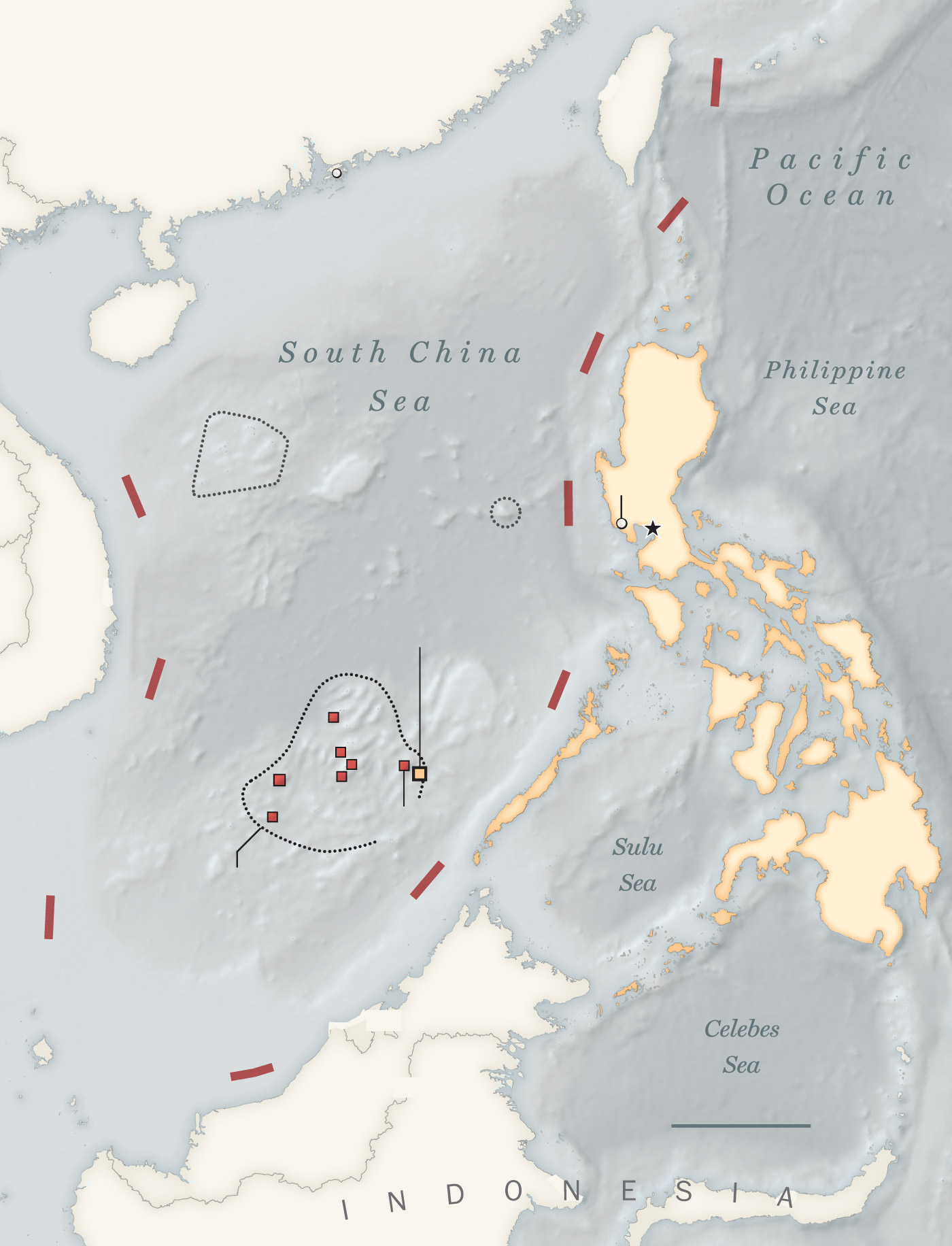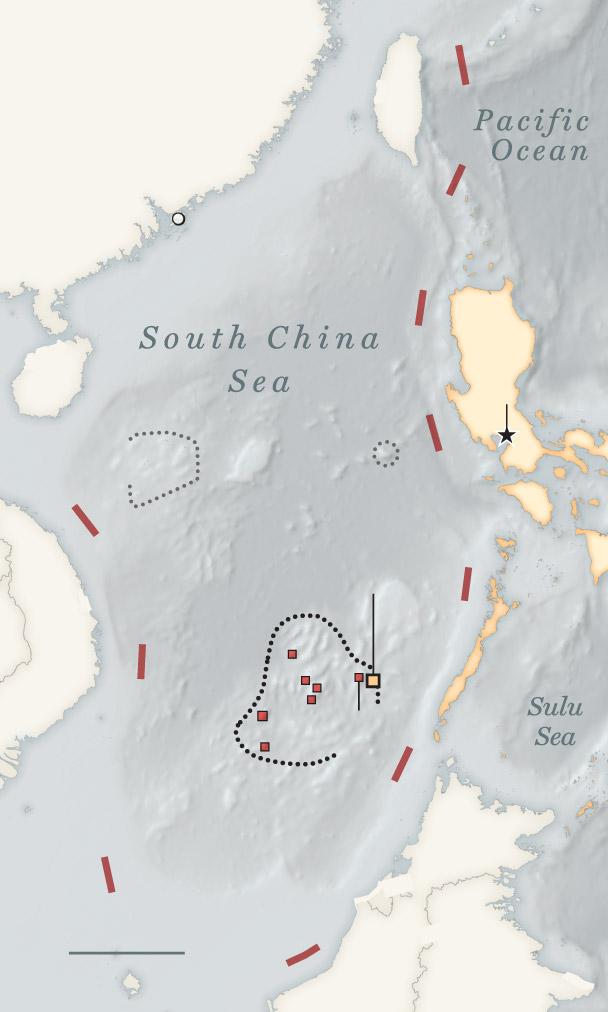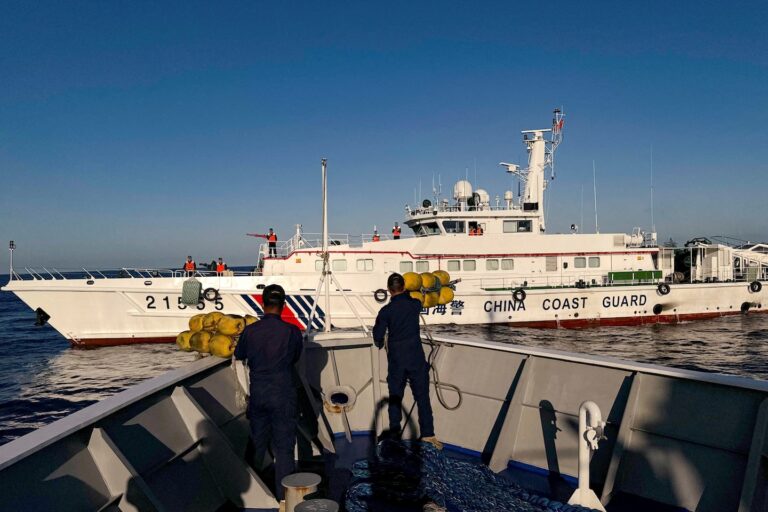The Chinese coast guard used knives and machetes to cut holes in a Philippine rubber boat approaching the outpost and seized equipment, including the sailors’ mobile phones, that was on board the navy vessel. Officials said the Chinese rubber boat collided with the Philippine boat at high speed, causing a Philippine sailor to lose a finger after his hand was pinned between the two vessels.

10-dotted line
China’s Maritime Claims
Seven Islands
occupied by china
Within
Spratly Islands
chain

China’s Maritime Claims
Seven Islands
Occupied by
China
Spratly Islands
chain

China’s Maritime Claims
Seven Islands
Occupied by
China
Spratly Islands
chain
At least seven other Filipino crew members were injured. The Chinese vessel then removed the contents of the two Philippine rubber boats and towed them away, according to Philippine authorities.
Get caught up in
Stories to keep you up to date
“This is piracy,” Philippine military chief of staff Gen. Romeo Brawner Jr. said at a news conference on Palawan island, 120 miles from the reef. “They illegally boarded our vessel and took our equipment. That’s piracy at its finest.” Brawner added that Philippine navy personnel “fired back” but chose not to use force because the Chinese forces were vastly outnumbered.
“Our aim is to deliver supplies to the troops in accordance with international law, but also to prevent war. We don’t want war,” he said.
Chinese Foreign Ministry spokesman Lin Jian told a news conference on Wednesday that the collision was blamed on the Philippines, claiming the Philippine vessels were carrying construction materials and weapons as part of a long-term occupation of Second Thomas Shoal, which China opposes. “The China Coast Guard took professional and restrained enforcement measures,” Lin said, adding that the Chinese military “did not take any direct measures against the Filipinos.”
Earlier this week, China Coast Guard spokesman Gan Yu said the Philippine supply ship had “deliberately and dangerously” approached the Chinese vessel, leading to the collision.
China is seeking control of the South China Sea, a strategic body of water also claimed in parts by six other countries. The Philippines, backed by the United States, has stepped up pushbacks against China, but Beijing’s response has been increasingly aggressive, security analysts say, which could spur a broader conflict in the Pacific.
Nowhere is the situation more precarious than at Second Thomas Shoal, one of the few areas where the Chinese and Philippine militaries both have territorial disputes, said Zach Cooper, a senior fellow at the American Enterprise Institute who studies U.S. strategy in Asia. The Philippines launched a Sierra Madre island onto the reef in 1999 and has since stationed a contingent of Marines there to create a human presence and assert its claim to the shoal.
“It’s the most problematic area in terms of leading to real, genuine conflict,” Cooper said. What happened on Monday was “very serious” and would likely lead to calls for U.S. intervention, he added.
The United States has a mutual defense treaty with the Philippines, and Biden administration officials have stressed in recent months that the U.S. military would respond to any armed attack on Philippine warships or personnel in the South China Sea. U.S. Ambassador to the Philippines Mary Kay Carlson on Tuesday condemned China’s “aggressive and dangerous actions” in the Sierra Madre mountains but did not say whether or how the U.S. would respond. A spokesman for the U.S. embassy in Manila declined to answer questions about a U.S. response.
Earlier this month, President Ferdinand Marcos Jr. said at a security summit in Singapore that if Filipinos were killed in an “intentional act,” it would be “close to an act of war” that could trigger a military response. “Our treaty partners are held to the same standard,” the president said, referring to the United States.
But the Philippines also has to be careful about when it asks the U.S. for help, said Manila-based security analyst Julio Amador. The Philippines has been accused by Beijing of being a U.S. “stooge,” a charge Philippine officials deny. Amador said conducting a resupply mission to Second Thomas Shoal in the face of China’s assertive presence was an “exercise of proxy power” for the Philippines. The government “wants to be able to do this without having to ask for help,” he said.
On Monday, Philippine ships were unable to reach the Sierra Madre mountains to resupply troops stationed on board, but Bronner said the Navy would try again. “We will defend our rights and we will fight for our future,” he said.
Dozens of Chinese vessels continued to surround Second Thomas Shoal as of Wednesday afternoon, according to ship-tracking data. A 12,000-ton Chinese coast guard vessel, perhaps the largest in the world, was also sailing toward Thitu Island in the Philippines, near Second Thomas Shoal, said Ray Powell, an analyst at Stanford University’s Gordian Knot Center for National Security Innovation.
Tan reported from Singapore. Lyric Lee reported from Seoul.

